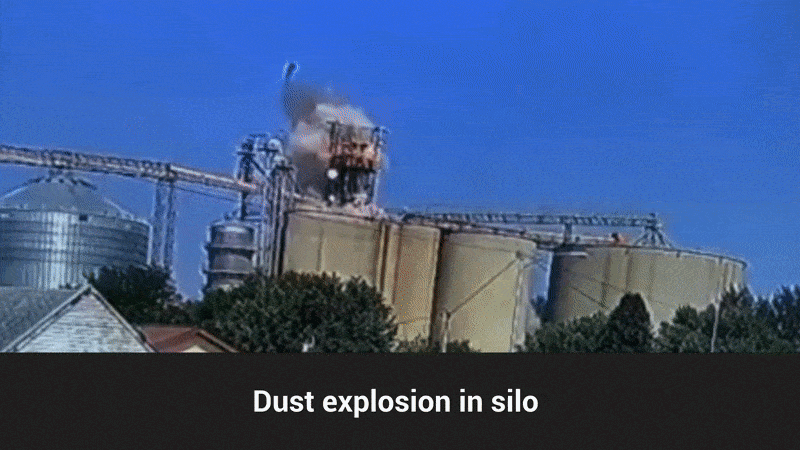Dust explosions in silos are not uncommon. On the contrary, up to 14% of industry dust explosions start in silos. What is more, such explosions can take a tragic toll, as was the case in 1979 in Bremen, Germany, when an explosion at an elevator complex claimed 14 lives and resulted in EUR 50 million worth of damage (as converted from Deutsche Marks used in Germany at that time). In most cases it is grain dust that explodes in silos.
Dust explosions in silos – statistics
The data published in a report titled. “2017 Combustible Dust Incident Report – Version #1” indicates that 14% of all industry dust explosions start in silos.
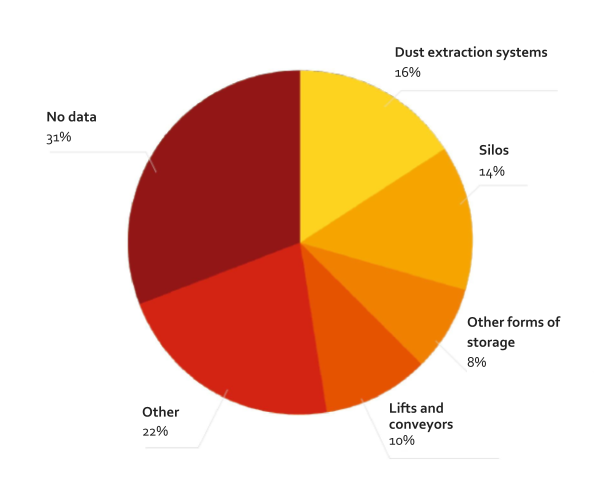
Fig. 1: Number of explosions by device
Product
As far as industry is concerned, food dust explosions are the most common – 32% of all cases – followed by wood dusts – 30% of all cases. The former group includes flour, sugar and grain dusts.
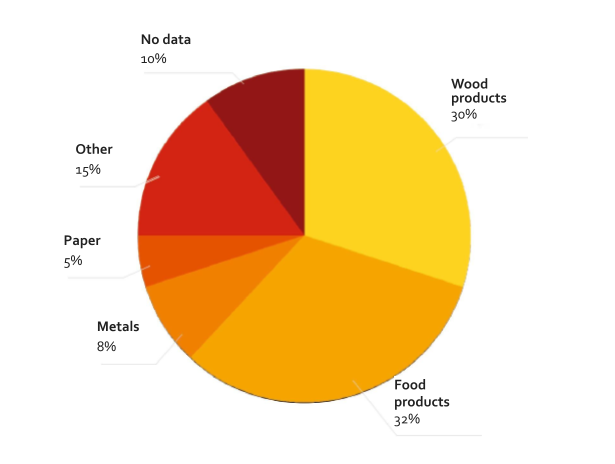
Fig. 2: Explosive dusts in industry
Metal dusts
Metal dusts are also an important group – they account for 8% of explosions. True, incidents involving metal dusts are less frequent but when such dusts explode, we are dealing with significantly increased dynamics and force of the explosion. This is particularly due to very high explosiveness parameters of these dusts – these include:
- Kst, i.e. the maximum rate of explosion pressure increase in time, which for metal dusts may even exceed 500 m*bar/s (most explosion mitigation safety devices are certified up to Kst 250 m*bar/s).
- Pmax, i.e. the maximum explosion pressure, which, in the case of metal dusts, may reach the level of up to 12 bar (typical structural strength of most devices, such as a silo or a dust collector, is within the range of 0.4 – 1 bar).
Are metal dusts also present at your plant? Learn more about metal dust explosion prevention.
At this point, one aspect should be clarified to avoid drawing erroneous conclusions. Food dusts, wood dusts and metal dusts (including alloy dusts) account for the majority of dust explosions. However, this does not mean that other dusts are less dangerous. Collectively, the above-mentioned dust account for 70% of explosions in industry. That still leaves us with 30% of incidents involving dozens of less obvious dust types. A good example is ammonium nitrate used in fertilizer production. This substance caused, for example, the powerful explosion in the port of Beirut
The following are examples of fairly common dusts used in industry.
Food and agricultural products
- cotton
- albumen
- fibre / cellulose
- hops
- sugar
- cork tree
- gluten
- tea
- cocoa
- semolina
- coffee
- lactose
- alfalfa
- wood meal
- oat flour/meal
- wheat flour/meal
- soybean flour/meal
- milk powder
- spices
- whey
- linseed
- lemon peel
- rice starch
- corn starch
- wheat starch
- potato starch
- malt
- dried fruit and vegetables
- tapioca
- tobacco
- oat grain
Metals
- aluminium
- bronze
- zinc
- magnesium
Chemicals
- anthraquinone
- sodium ascorbate
- aspirin
- ammonium nitrate
- adipic acid
- ascorbic acid
- maltodextrin
- calcium acetate
- paraformaldehyde
- sulphur
- lead stearate
- sodium stearate
- calcium stearate
Solid fuels and their derivatives
- biomass
- coke
- carbon black
- brown coal
- charcoal
- hard coal
Plastics
- urea formaldehyde
- melamine
- polyvinyl derivatives
- polyacrylamide (PAM)
- Poly (methyl acrylate)
- polyacrylonitrile (PAN)
- polypropylene (PP)
- polyethylene (PE)
- epoxy resin
- phenolic resin
- melamine resin
Frequency
In many countries, information on explosions is not recorded and thus general statistics are not available. Therefore, in order to demonstrate the frequency of dust explosions in silos and for the purpose of this paragraph, we will use the data obtained by Purdue University of the United States of America. Over the past 10 years, Purdue University researchers have collected data attesting to a total of 81 explosions, 46 of which began in grain elevators. It should be noted that the data applies to grain dust only.
Explosion at Tilbury docs in Essex (UK)
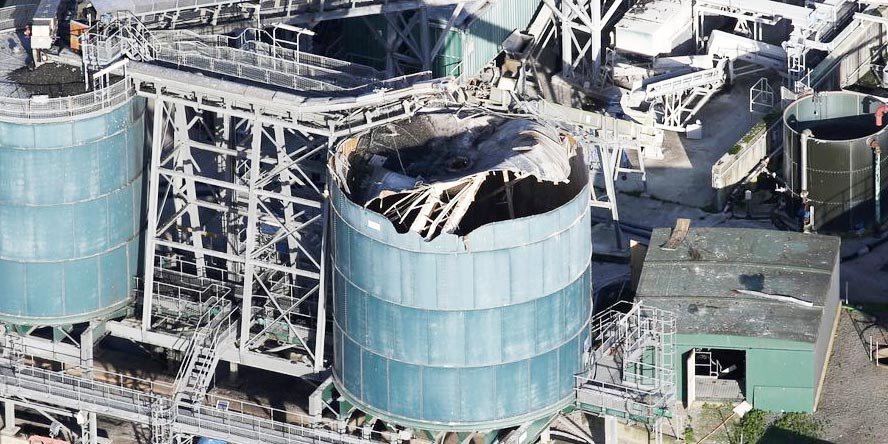
Tilbury docks is the largest grain terminal in the UK. Its annual handling capacity is approximately two million tonnes. The terminal consists of 200 separate silos, each capable of holding between 60 and 300 tonnes of grain.
On July 3, 2020, there was a violent explosion of grain dust which destroyed several silos and produced flames reaching the height of 75 meters. The fire brigade called to the scene worked at the site of the explosion for as long as 20 days, as fire-fighters had to extinguish, again and again, smouldering grain fires from the destroyed silos. The direct cause of the explosion, which the fire department describes as “accidental”, has not been determined.
Explosion at Ag Partners in Royal (Iowa, USA)
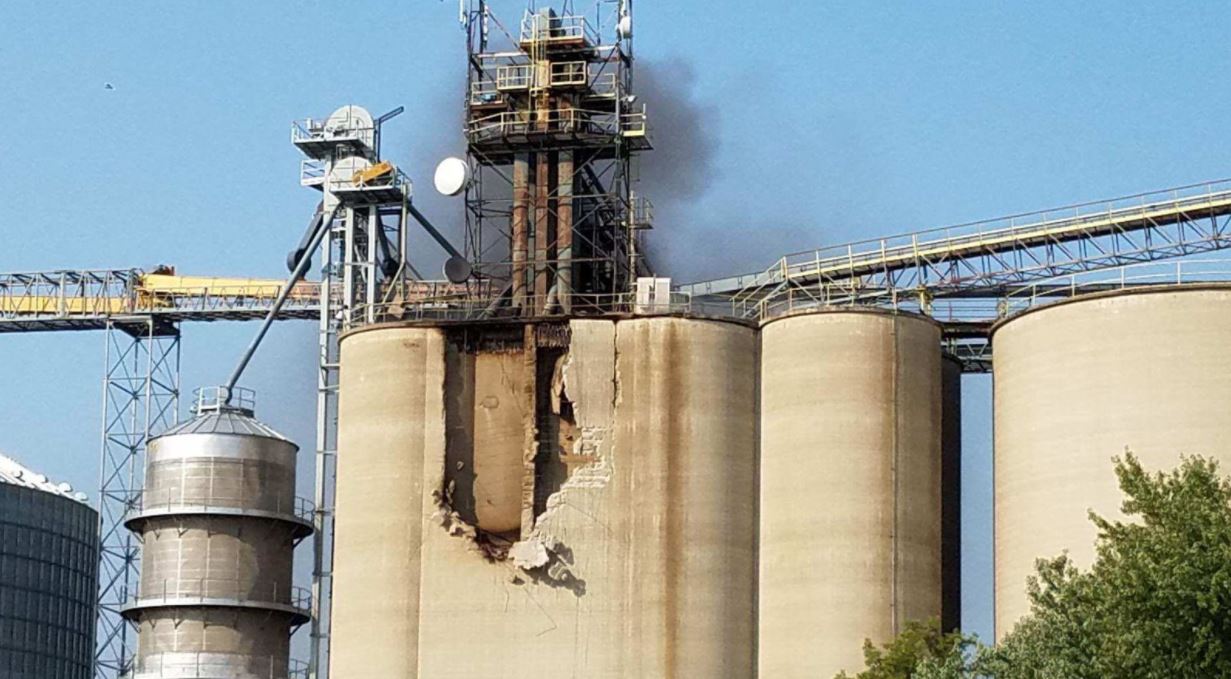
The explosion, caused by unknown reasons, occurred in a silo where a mixture of corn and soybean was stored. The explosion destroyed the silo along with the adjacent installations.
What is interesting here, is that the elevator was mostly empty at the time of explosion. This meant that there was a large volume of air inside the silo, which could potentially create an explosive atmosphere when combined with dust which could certainly be found inside the silo. This is a situation similar to an explosion inside a car fuel tank. The less fuel and the more vapours, forming an explosive mixture with the air inside the tank, the more powerful the explosion.
What is the source of the threat?
Explosive atmosphere
Mariusz Balicki, a WOLFF GROUP explosion safety expert, explains that w there is always air in silos, and thus oxygen, which is necessary for an explosion to take place. Whereas the grain (or other dry product) stored inside a silo causes a deposit of dust to form inside. During loading and unloading operations, such deposits, due to the movement caused by air circulation, may become airborne and thus create a dangerous mixture of dust and air, i.e. an explosive atmosphere. Additionally, Mr. Balicki stresses that filling a previously emptied silo (e.g. due to a failure or the need to carry out repairs) is extremely dangerous. For this reason, the entire inside volume of a silo where a product capable of creating an explosive atmosphere is stored is considered a 20 zone.
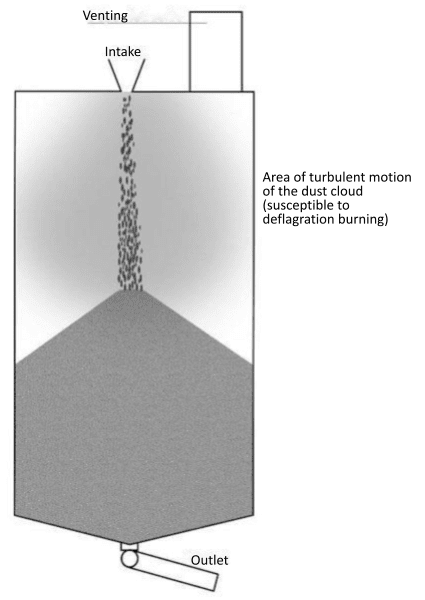
Fig. 3: The phenomenon of segregation of bulk material during silo filling
It should be also noted that dusting during loading and unloading of a silo is not limited strictly to the inside of the silo. Bucket elevators, belt conveyors or other handling equipment in the immediate vicinity of a silo can also be a source of danger. Therefore, the safety devices installed on a silo should constitute only a part of a broader system protecting the entire plant against the effects of an explosion. When selecting protective measures, one should start with the elimination of explosive atmospheres (e.g. by applying dust extraction). As the next step, one should reduce the risk of the occurrence of potential ignition sources (e.g. by means of proper operation of the equipment). Finally, individual pieces of equipment and apparatuses should be protected and explosion isolation systems should be deployed.
Ignition source
The most common sources of ignition in a silo or installations adjacent to a silo include the following:
- surfaces which become hot due to friction caused by faulty mechanisms,
- glowing particles entering the silo along with the transported material,
- mechanical sparks generated by the impact of metal elements found in the transported material,
- sparks from welding and other hot works conducted in the immediate vicinity,
- unsuitable or defective electrical equipment (e.g. motors or lighting fixtures),
- grinding or cutting of metals during repair works,
- static electricity discharge,
- microbial activity.
Myth – corn is relatively safe
When looking for information on the explosiveness parameters of different dusts from products stored in silos, you need to be cautious, as you can find a lot of information on the Internet that does not fully reflect the actual hazard. This is the case with corn dust, among others. It is fairly easy to find information portraying corn dust as relatively safe as compared to other grain dusts. To make matters worse, this information can be found on a site which is commonly believed to be reliable. Such a statement may induce an unfounded sense of security in a reader and consequently lead to negligence in terms of measures aiming at improving explosion safety.
While it was corn dust that caused one of the most tragic grain dust explosions in the last 5 years. Didion Mill production facility was ordered to pay over PLN 6.5 million in fines (over USD 1.8 million) due to a corn dust explosion that killed five people and injured 14 others. The first, relatively small explosion in the mill escalated quickly. There was a series of secondary explosions that caused the collapse of 4 out of the 9 buildings that made up the production complex. The other 5 buildings were severely damaged.
A detailed description of the incident, including interactive materials, can be found in
Silos – the impact of the their structure on their compatibility with safety devices
Problem No. 1: Adjacent silos located outside
The diagram below illustrates a common installation found on industrial sites consisting of the following elements:
- acceptance of the raw material (and e.g. milling or sifting),
- transport of the raw material to silos for storage,
- collection of the raw material from the silos for the purpose of its use in the further section of the installatio
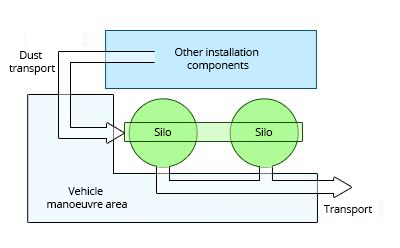
Fig. 4: Exemplary installation
The following is based on the assumption that the stored product is not toxic. So let us consider the most popular and at the same time the cheapest type of protection against the effects of an explosion, i.e. explosion relief by means of using decompression panels..
The following diagram demonstrates potential consequences of a dust explosion in an unprotected silo or even in a silo theoretically protected through the use of decompression panels installed on the cylindrical part of the silo. The lack of protection or installation of decompression panels facing other elements of the installation (which, unfortunately, is very common) poses a threat to other equipment as well as the life and health of workers. The following animation demonstrates, how far a fireball coming out of decompression panels can reach.
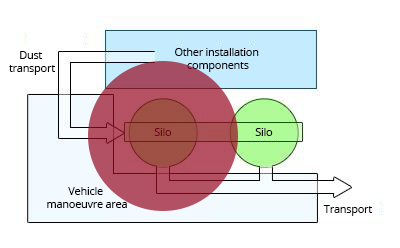
Fig. 5: Hazard resulting from the installation of decompression panels on the cylindrical part of a silo
Animation No. 1: Range of the blast wave
When examining such an installation type, one could theoretically consider placing the decompression panels on the roof of the left-hand silo and on the cylindrical section to the right in the case of the right-hand silo. In such a case, the direction of the forces during the relief of the explosion would be as follows:
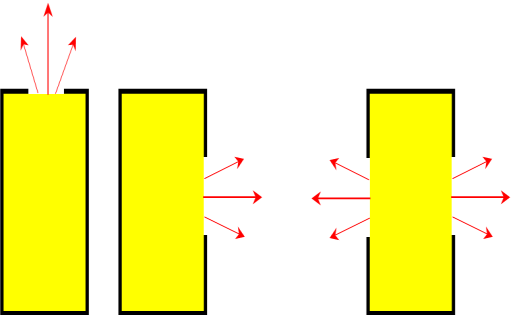
Fig. 6: Theoretically possible location of decompression panels
However, whether or not this solution is feasible depends on the structure of the silo. First of all, its slenderness ratio (the height to diameter ratio H/D) will be a decisive factor; this will tell us whether there will be enough space on the roof of the left-hand silo to provide sufficient area for the installation of the decompression panels.
To determine this, appropriate calculations must be performed. The results of such exemplary calculations are shown below for silos of identical volume V = 1000 m3. The calculations were performed for dust with Kst = 150 bar m/sec, Pmax = 9 bar. The assumed structural strength of the silo, Pstat = 0.5 bar g, is an important parameter in this case.
| The impact of silo slenderness ratio (H/D, F - silo roof area): | |||||
| H/D | 1 | 2 | 3 | 4 | 5 |
| H, m | 10.8 | 17.2 | 22.6 | 27.3 | 31.7 |
| D, m | 10.8 | 8.6 | 7.5 | 6.8 | 6.3 |
| F, m2 | 92 | 58 | 44 | 36 | 31 |
| Av, m2 | 12 | 19 | 24 | 27 | 29 |
| Av/F,% | 13 | 33 | 55 | 75 | 95 |
Table 1: The impact of silo slenderness ratio on the decompression surface
As demonstrated, the silo slenderness ratio is crucial, because as the ratio increases, the required decompression area also increases while the silo roof area, i.e. the area on which decompression panels can be mounted, decreases.
For silos with slenderness ratio in excess of 3, the required decompression area is so large (more than 50% of the roof area) that protecting the silo with roof mounted decompression panels is unlikely to be feasible. Such a solution can be classified as a medium or even, in some cases, high risk also due to the danger to employees during periodic inspections or repairs. Therefore, other means of protection, such as flameless explosion relief or explosion suppression, should be considered.
Problem No. 2: An indoor silo (e.g. installed in a production hall or a warehouse)
In the event a silo is located indoors, close to an exterior wall or the roof, you could theoretically consider using decompression panels along with a vent duct.
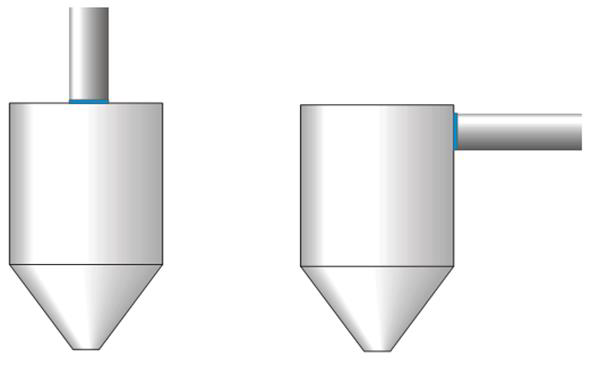
Fig. 7: Installation of decompression panels with a vent duct
This solution is only feasible if the outlet of the vent duct routed to the outside of the building is not directed at any other parts of the installation, other buildings or roads. However, even in such a case, appropriate calculations should be performed to demonstrate the profitability of this type of protection.
Please find below an example of such calculations for silos of different volumes. The calculations were performed for dust with Kst = 150 bar m/sec, Pmax = 9 bar. The assumed structural strength of silo Pstat = 0.4 bar g (explosion relief without a duct).
| Duct L, m | 0 | 6* | 6** | 0 | 6* | 6** |
| Silo V, m3 | 195 | 195 | 195 | 28 | 28 | 28 |
| H/D | 2.0 | 2.0 | 2.0 | 3.0 | 3.0 | 3.0 |
| Av, m2 | 6.9 | 3.5 | 2.4 | 2.0 | 0.6 | 0.5 |
| Pstat, bar | 0.4 | 1.6 | 1.8 | 0.4 | 1.7 | 1.9 |
| * relief duct installed horizontally (on the cylindrical part of the silo) | ||||||
| ** relief duct installed vertically (on the silo roof) | ||||||
Table 2: The impact of the installation of a relief duct on the silo on its structural strength and the required decompression area
In order to select suitable safety devices for a silo, two variables can be used in our calculations: the required decompression area and the structural strength of the silo. An increase in one parameter causes a decrease in the other. This means, for example, that if pressure can be vented from a silo over a large area, increasing its structural strength is not required, because the pressure will have time to vent through the decompression panels before it destroys the silo.
However, in the case of an indoor silo and the need for decompression ducts, the decompression area cannot be freely increased, as we must remember that the released pressure must still travel through a sufficiently long and robust duct before it can be released outside. Additionally, in the case of long decompression ducts a secondary explosion may occur, which would be caused by burning and unburned particles travelling along with pressure and fire. Such an explosion could even reach back to the silo.
Therefore, when calculations are made for the purpose of selecting suitable safety devices, it is often the case that a reduction in the decompression area is required along with the installation of a decompression duct and consequently it becomes necessary to increase the structural strength of the silo, which is usually not a financially viable option.
If such a case, one should consider using a flameless explosion relief system instead of decompression panels.
